tow OLDSMOBILE SILHOUETTE 2003 Workshop Manual
[x] Cancel search | Manufacturer: OLDSMOBILE, Model Year: 2003, Model line: SILHOUETTE, Model: OLDSMOBILE SILHOUETTE 2003Pages: 466, PDF Size: 21.55 MB
Page 321 of 466
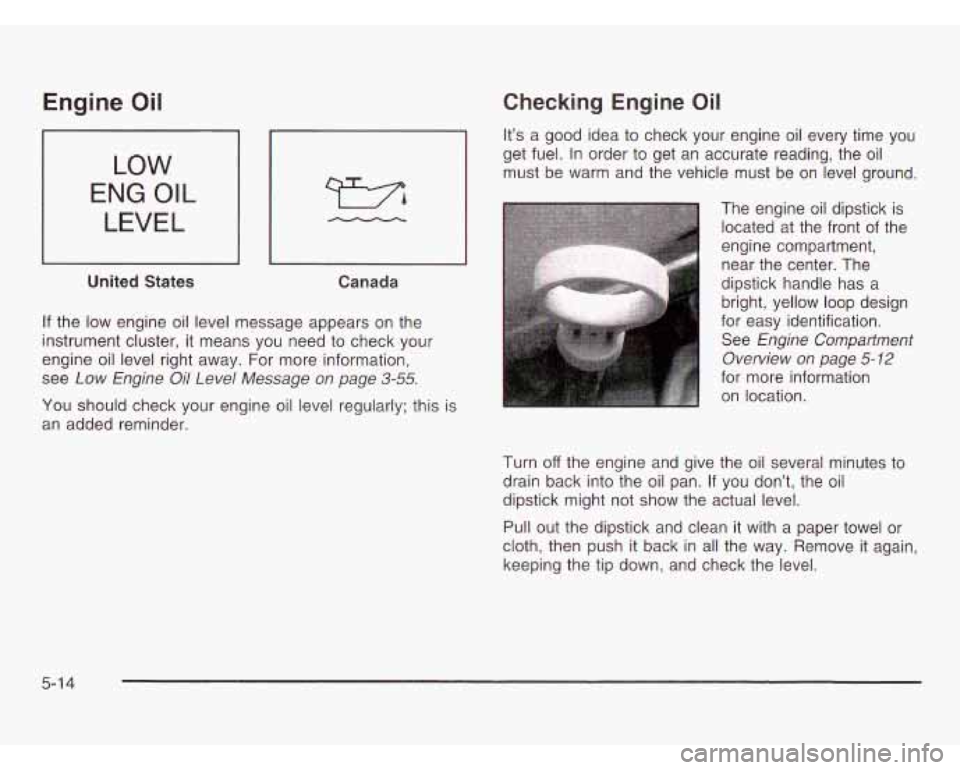
Engine Oil
LOW
ENG OIL
LEVEL
United States
Canada
If the low engine oil level message appears on the
instrument cluster, it means you need to check your
engine oil level right away. For more information,
see
Low Engine Oil Level Message on page 3-55.
You should check your engine oil level regularly; this is
an added reminder.
Checking Engine Oil
It’s a good idea to check your engine oil every time you
get fuel. In order to get an accurate reading, the oil
must be warm and the vehicle must be on level ground.
The engine oil dipstick is
located at the front of the
engine compartment,
near the center. The
dipstick handle has a
bright, yellow loop design
for easy identification. See
Engine Compartment
Overview on page
5- 12
for more information on location.
Turn
off the engine and give the oil several minutes to
drain back into the oil pan. If you don’t, the oil
dipstick might not
show the actual level.
Pull out the dipstick and clean it with a paper towel or
cloth, then push
it back in all the way. Remove it again,
keeping the tip down, and check the level.
5-1 4
Page 327 of 466

Automatic Transaxle Fluid
When to Check and Change
A good time to check your automatic transaxle fluid
level is when the engine oil is changed.
Change both the fluid and filter every
50,000 miles
(83
000 km) if the vehicle is mainly driven under one or
more of these conditions:
In heavy city traffic where the outside temperature
regularly reaches 90°F (32°C) or higher.
In hilly or mountainous terrain.
When doing frequent trailer towing.
Uses such as found in taxi, police or delivery
service.
If you do not use your vehicle under any of
these conditions, change the fluid and filter at
100,000 miles (1 66 000 km).
See
Part A: Scheduled Maintenance Services
on page
6-4.
How to Check
Because this operation can be a little difficult, you may
choose to have this done at the dealership service
department.
If you do it yourself, be sure to follow all the instructions
here, or you could get a false reading on the dipstick.
Notice: Too much or too little fluid can damage your
transaxle.
Too much can mean that some of the fluid
could come out and fall
on hot engine or exhaust
system parts, starting a fire.
Too little fluid could
cause the transaxle to overheat. Be sure to get an
accurate reading if you check your transaxle fluid.
Wait at least
30 minutes before checking the transaxle
fluid level
if you have been driving:
When outside temperatures are above 90°F (32°C).
At high speed for quite a while.
In heavy traffic - especially in hot weather.
While pulling a trailer.
To get the right reading, the fluid should be at normal
operating temperature, which
is 180°F to 200°F
(82°C to 93°C).
Get the vehicle warmed up by driving about
15 miles
(24 km) when outside temperatures are above 50°F
(1 0°C). If it's colder than 50°F (1 OOC), you may have to
drive longer.
5-20
Page 328 of 466
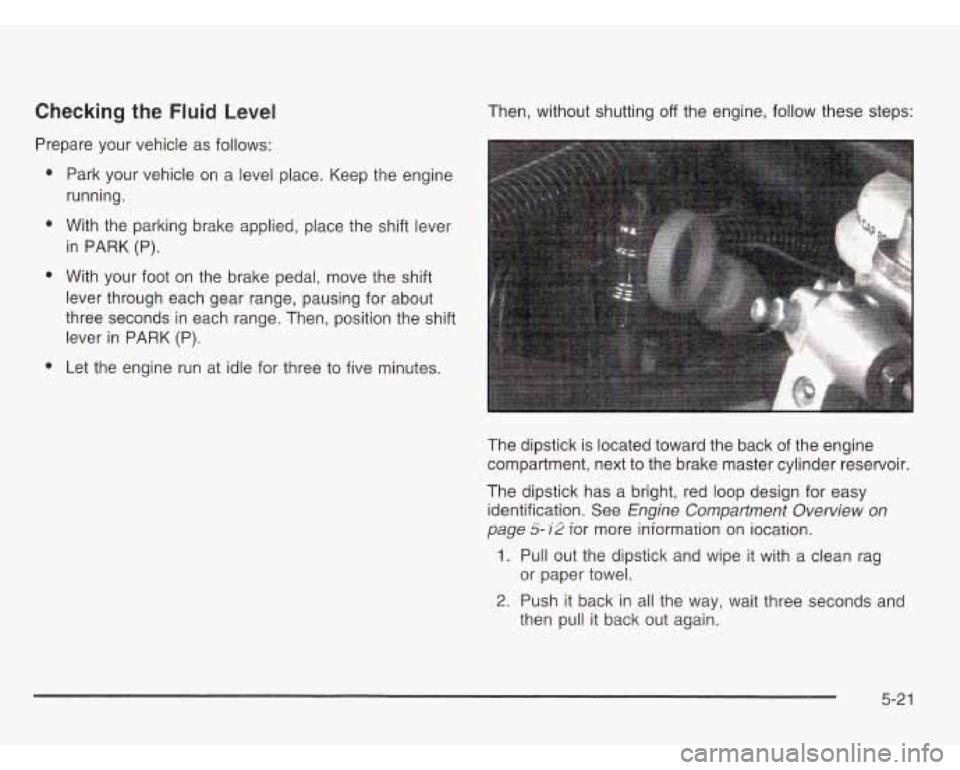
Checking the Fluid Level
Prepare your vehicle as follows:
e
e
e
Park your vehicle on a level place. Keep the engine
running.
With the parking brake applied, place the shift lever
in PARK (P).
With your foot on the brake pedal, move the shift
lever through each gear range, pausing for about
three seconds in each range. Then, position the shift
lever in PARK (P).
Let the engine run at idle for three to five minutes. rhen,
without shutting
off the engine, follow these steps:
The dipstick is located toward the back of the engine
compartment, next to the brake master cylinder reservoir
The dipstick has a bright, red loop design for easy
identification. See
Engine Compartment Overview on
page
5- 12 ior more information on iocation.
1. Pull out the dipstick and wipe it with a clean rag
2. Push it back in all the way, wait three seconds and
or
paper towel.
then pull
it back out again.
5-2 1
Page 333 of 466

Radiator Pressure Cap
Notice: Your radiator cap is a pressure-type cap
and must be tightly installed to prevent coolant
loss
and possible engine damage from overheating.
Be sure the arrows on the cap line
up with the
overflow tube on the radiator filler neck.
The radiator pressure cap is located at the front of the
engine compartment on the passenger’s side of the
vehicle. See
Engine Compartment Overview on
page 5-72 for more information on location.
Engine Overheating
You will find an engine coolant temperature gage on
your vehicle’s instrument panel cluster. See
Engine
Coolant Temperature Gage
on page 3-47. You also
have an engine coolant temperature warning message
on your instrument panel. See
Engine Coolant
Temperature Warning Message
on page 3-53.
Overheated Engine Protection
Operating Mode
This emergency operating mode allows your vehicle to
be driven to a safe place in an emergency situation.
If an overheated engine condition exists, an overheat
protection mode which alternates firing groups of
cylinders helps prevent engine damage.
In this mode,
you will notice a significant
loss in power and engine
performance. The temperature gage will indicate
an overheat condition exists. Driving extended miles
(km) and/or towing a trailer in the overheat protection
mode should be avoided.
Notice: After driving in the overheated engine
protection operating mode, to avoid engine damage,
allow the engine to cool before attempting any repair. The engine oil will be severely degraded.
Repair the cause
of coolant loss, change the oil
and reset the
oil life system. See “Engine Oil” in
the Index.
5-26
Page 335 of 466
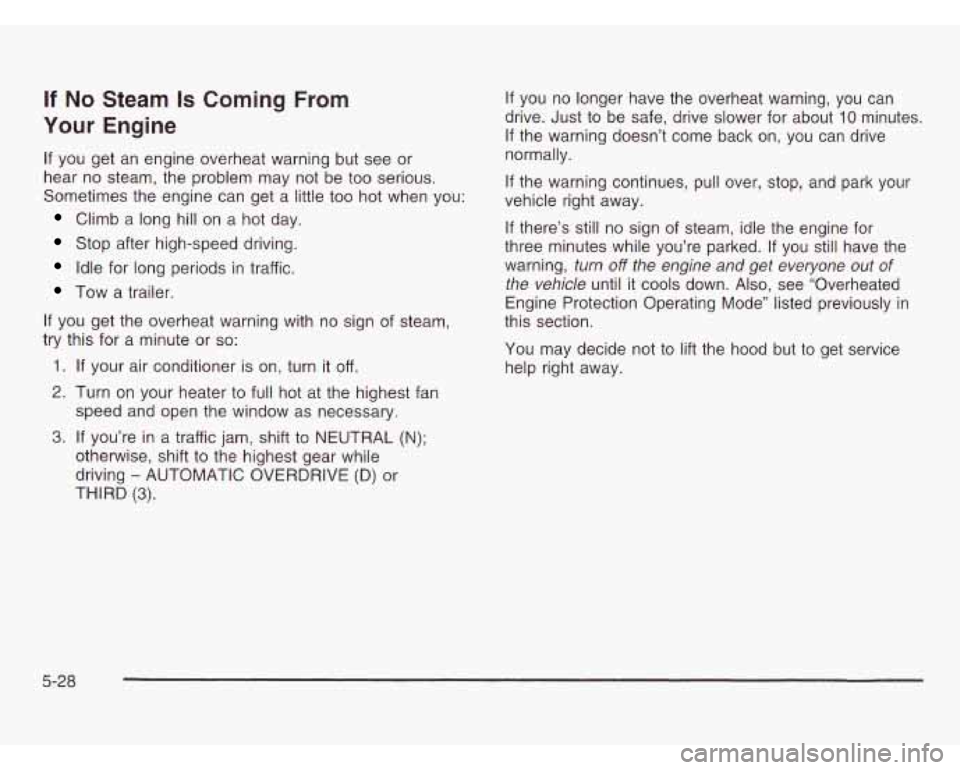
If No Steam Is Coming From
Your Engine
If you get an engine overheat warning but see or
hear no steam, the problem may not be too serious.
Sometimes the engine can get a little
too hot when you:
Climb a long hill on a hot day.
Stop after high-speed driving.
Idle for long periods in traffic.
Tow a trailer.
If you get the overheat warning with no sign of steam,
try this for a minute or
so:
1. If your air conditioner is on, turn it off.
2. Turn on your heater to full hot at the highest fan
speed and open the window as necessary.
3. If you’re in a traffic jam, shift to NEUTRAL (N);
otherwise, shift to the highest gear while
driving
- AUTOMATIC OVERDRIVE (D) or
THIRD
(3).
If you no longer have the overheat warning, you can
drive. Just to be safe, drive slower for about
10 minutes.
If the warning doesn’t come back on, you can drive
normally.
If the warning continues, pull over, stop, and park your
vehicle right away.
If there’s still no sign of steam, idle the engine for
three minutes while you’re parked. If you still have the
warning,
turn off the engine and get everyone out of
the vehicle until it cools down. Also, see “Overheated
Engine Protection Operating Mode” listed previously in
this section.
You may decide not to
lift the hood but to get service
help right away.
5-28
Page 366 of 466
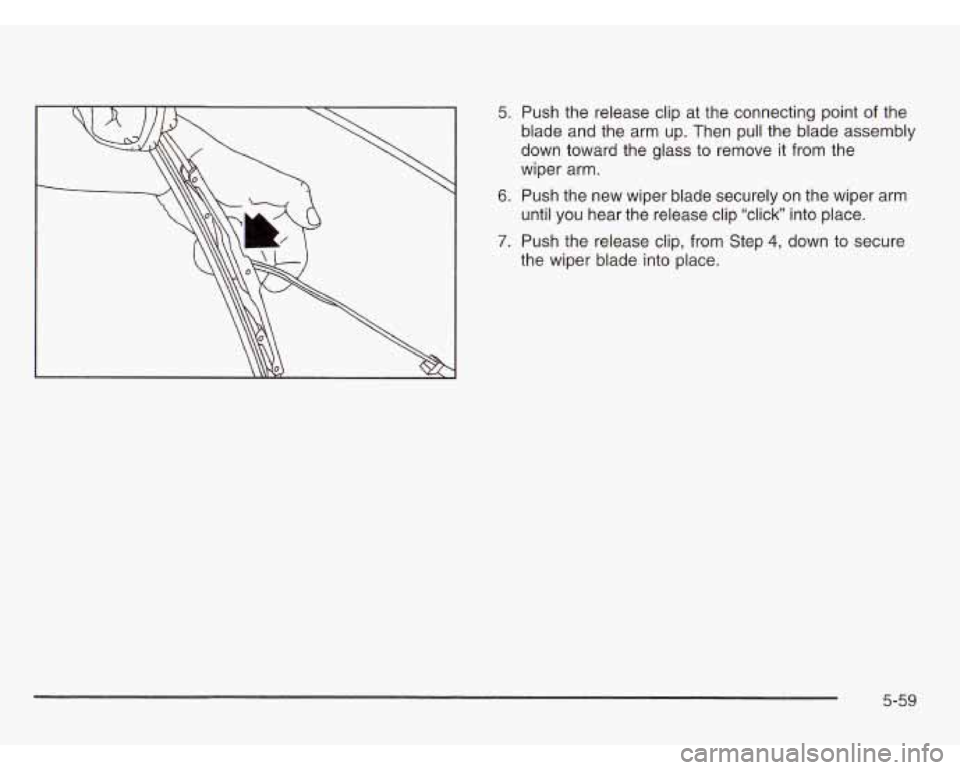
5. Push the release clip at the connecting point of the
blade and the arm up. Then pull the blade assembly
down toward the glass to remove it from the
wiper arm.
6. Push the new wiper blade securely on the wiper arm
until you hear the release clip “click” into place.
7. Push the release clip, from Step 4, down to secure
the wiper blade into place.
5-59
Page 370 of 466

After the tires have been rotated, adjust the front and rear
inflation pressures as shown on the Certification/Tire
label. Make certain that all wheel nuts are properly
tightened. See “Wheel Nut Torque” under
Capacities and
Specifications on page 5-
103.
-3ust or dirt on a wheel, or on the parts to
which
it is fastened, can make wheel nuts
become loose after a time. The wheel could
come
off and cause an accident. When you
change a wheel, remove any rust or
dirt from
places where the wheel attaches to the vehicle.
In an emergency, you can use a cloth or a
paper towel to do this; but be sure to use a
scraper or wire brush later, if you need to, to
get all the rust or dirt
off. See “Changing a Flat
Tire”
in the Index.
When It Is Time for New Tires
One way to tell when it’s
time for new tires is to
check the treadwear
indicators, which will
appear when your tires
have only
1/16 inch
(1.6 mm) or less of tread
remaining.
You need a new tire
if any of the following statements
are true:
You can see the indicators at three or more places
You can see cord or fabric showing through the
The tread or sidewall is cracked, cut or snagged
The tire has a bump, bulge or split.
The tire has a puncture, cut or other damage that
around the tire.
tire’s rubber. deep enough to show cord or fabric.
__ can’t be repaired well because of the size or
location
of the damage.
5-63
Page 376 of 466

Your air inflator will automatically shut off after about
10 minutes. The light in the switch will blink. After about
one minute you can use the system again. Press the
inflator switch and the indicator light will come on.
Notice: Don’t run your air inflator for longer than
30 minutes at one time. If you do, you may damage
the system.
After running the air inflator for
30 minutes, wait at least
10 minutes before restarting the air inflator.
To turn off the inflator, do the following:
1. Press the switch and detach the hose, first from the
2. Put the protective cap back on.
3. Place the inflator kit tools in the pouch, and store in
inflated
object, then from the outlet.
the glove box.
To put the cover back on, line up the tabs at the back
of the cover and put it in place. Push down the tab
to secure the cover.
If a Tire Goes Flat
It’s unusual for a tire to “blow out” while you’re driving,
especially
if you maintain your tires properly. If air
goes out of a tire, it’s much more likely to leak out
slowly. But if you should ever have a “blowout”, here are
a few tips about what to expect and what to do:
If a front tire fails, the flat tire will create a drag that
pulls the vehicle toward that side. Take your foot
off the
accelerator pedal and grip the steering wheel firmly.
Steer to maintain lane position, and then gently brake
to a stop well out of the traffic lane.
A rear blowout, particularly on a curve, acts much like
a skid and may require the same correction you’d use
in a skid. In any rear blowout, remove your foot from
the accelerator pedal. Get the vehicle under control by
steering the way you want the vehicle to go. It may
be very bumpy and noisy, but you can still steer.
Gently brake to a stop
- well off the road if possible.
If a tire goes flat, the next part shows how to use
your jacking equipment to change a flat tire safely.
5-69
Page 380 of 466
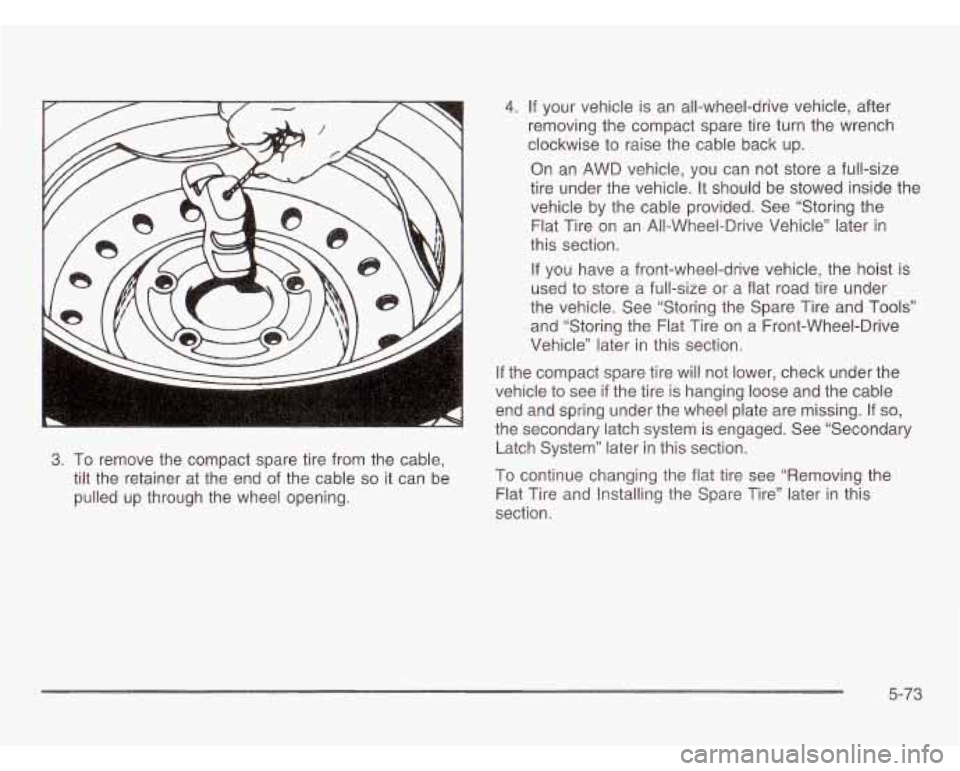
3. To remove the compact spare tire from the cable,
tilt the retainer at the end
of the cable so it can be
pulled up through the wheel opening.
-. If your vehicle is an all-wheel-drive vehicle, after
removing the compact spare tire turn the wrench
clockwise to raise the cable back up.
On an AWD vehicle, you can not store
a full-size
tire under the vehicle. It should be stowed inside the
vehicle by the cable provided. See “Storing the
Flat Tire on an All-Wheel-Drive Vehicle” later
in
this section.
If you have a front-wheel-drive vehicle, the hoist is
used to store a full-size or a flat road tire under
the vehicle. See “Storing the Spare Tire and
Tools”
and “Storing the Flat Tire on a Front-Wheel-Drive
Vehicle” later
in this section.
If the compact spare tire will not lower, check under the
vehicle to see
if the tire is hanging loose and the cable
end and spring under the wheel plate are missing. If
so,
the secondary latch system is engaged. See “Secondary
Latch System” later
in this section.
To continue changing the flat tire see “Removing the
Flat Tire and Installing the Spare Tire” later in this
section.
5-73
Page 381 of 466
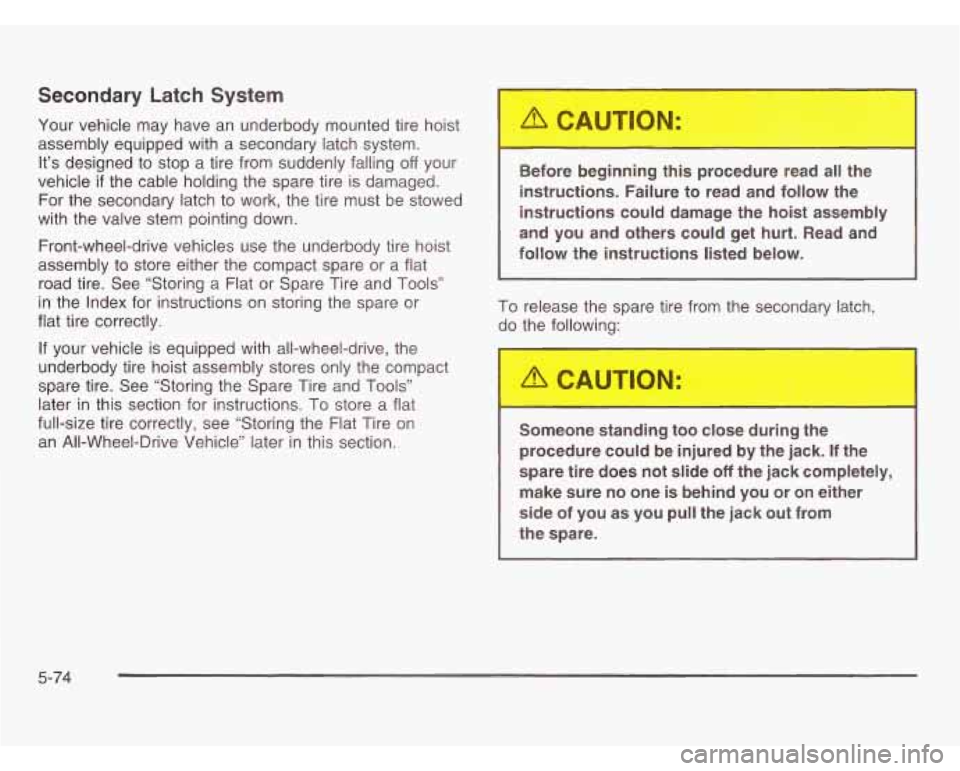
Secondary Latch System
Your vehicle may have an underbody mounted tire hoist
assembly equipped with a secondary latch system.
It‘s designed to stop a tire from suddenly falling off your
vehicle
if the cable holding the spare tire is damaged.
For the secondary latch to work, the tire must be stowed
with the valve stem pointing down.
Front-wheel-drive vehicles use the underbody tire hoist
assembly to store either the compact spare or a flat
road tire. See “Storing a Flat or Spare Tire and
Tools”
in the Index for instructions on storing the spare or
flat tire correctly.
If your vehicle is equipped with all-wheel-drive, the
underbody tire hoist assembly stores only the compact
spare tire. See “Storing the Spare Tire and Tools”
later in this section for instructions. To store a flat
full-size tire correctly, see “Storing the Flat Tire
on
an All-Wheel-Drive Vehicle” later in this section. Before beginning this procedure read all the
instructions. Failure to read and follow the
instructions could damage the hoist assembly
and you and others could get hurt. Read and
follow the instructions listed below.
To release the spare tire from the secondary latch,
do the
f .. )wing:
Someone standing too close during the procedure could be injured by the jack.
If the
spare tire does not slide
off the jack completely,
make sure no one is behind you or on either
side of you as you pull the jack out from
the spare.
5-74